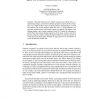Free Online Productivity Tools
i2Speak
i2Symbol
i2OCR
iTex2Img
iWeb2Print
iWeb2Shot
i2Type
iPdf2Split
iPdf2Merge
i2Bopomofo
i2Arabic
i2Style
i2Image
i2PDF
iLatex2Rtf
Sci2ools
DAGSTUHL
2003
2003
Agent-Environment Interaction in Visual Homing
Abstract. This study illustrates how obstacle avoidance can emerge from a visual homing strategy, caused by the intrinsic geometric structure of the environment. An example is shown where an agent performs visual homing in a virtual environment with several obstacles which also serve as visual landmarks. The agent has omnidirectional vision similar to many prey animals. The applied visual homing strategy is the Average Landmark Vector (ALV) model by Lambrinos et al.[1]. When observing the homing trajectories of the agent, it can be seen that it performs obstacle avoidance without having this behaviour explicitly encoded. It will be shown that the dynamic feedback the agent gets from its environment is crucial for this kind of behaviour.
| Added | 31 Oct 2010 |
| Updated | 31 Oct 2010 |
| Type | Conference |
| Year | 2003 |
| Where | DAGSTUHL |
| Authors | Verena Vanessa Hafner |
Comments (0)

